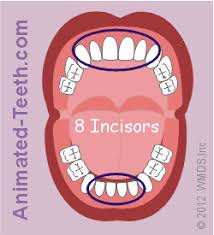The fall of our first teeth usually begins around five or six years of age, when a long process of falling and renewing teeth begins in order to achieve definitive teeth, as the adult teeth grow and begin to emerge, they push out the baby teeth, causing them to fall off.
The moment of the fall of each baby (or deciduous) tooth, which is 20 in total, is approximate, since there may be variations due to genetics or other reasons. The lower teeth, which were probably the first to appear, are also usually the first to fall.
The lower incisors are born in the internal part of the gum, behind the baby teeth, pushing these outwards. In the mouths of the children, you can see the pits of the new incisors behind the deciduous incisors, which have not yet fallen.
The upper teeth are born in front of the gum pushing the baby teeth inward before they fall. The upper central incisors fall at around 6 or 7 years of age. The first definitive molar will come out behind the last deciduous teeth. These teeth do not replace any other but occupy the free space behind the second molars, which have not yet fallen, and we live with them for some years. The bottom ones appear first and then the top ones.
What to do when a tooth starts coming out?
The recommendation is not to force it, because it can take a long time since it starts to move until it falls, and forced movements can damage the final tooth or the gum. It is important to avoid touching it with the tongue or with the other teeth to cause its detachment. However, when it is very loose and moves so much that it bothers the child to talk or eat, we can go ahead and remove it. If moving it does not hurt, is that it is loose.
Why do deciduous teeth fall?

The fall of baby teeth occurs when the permanent teeth, which are under the gum, begin to press and loosens the first ones little by little. The teeth fall leaving a gap where the new tooth appears. The definitive teeth protrude in the gum, eroding the roots of the baby teeth, which will begin to move until they fall.
How are the final teeth positioned?
The permanent teeth that come out are larger than the baby ones, so the separation they had between them disappears when they fall. New adult teeth, being larger than those of deciduous, are not always well positioned or do not have enough space to be placed correctly and be left “where they can”.
In general, during the change of dentition, some teeth can go crooked, but when the maxillofacial bone develops and it is completed they are aligned a little on their own. However, when the dental alignment is not good, the final teeth erupt next to the baby teeth and not under it, without wearing down its root. Then, both will appear in the mouth, forming a double row of teeth. This is more frequent in the incisors and it is advisable to inform the dentist to anticipate the fall of the baby teeth since when the definitive one finds its hole it will move occupying the empty place.
How to brush your teeth and floss.

Your child may need some help brushing his teeth until between 7 and 10 years old. Even if your intentions are good, you may not have the dexterity to clean his teeth well. Ideally, the teeth should be brushed within five to ten minutes after eating.
For long-term dental health, it is necessary for your child to take care of his gums as well; He should be taught to floss regularly, preferably once a day, to help prevent any gum (or periodontal) disease as an adult. A toothpaste for tartar control can help prevent plaque from sticking to your child’s teeth. In addition, fluoride in toothpaste can strengthen the exposed outer enamel of children’s teeth and help prevent cavities. Fluoride can also be added to the water supply in many cities. If your own tap water has less than the recommended levels of this nutrient, your pediatrician may suggest that you add fluoride to your child’s diet starting at 6 months of age, often as part of a vitamin supplement. .Fluoride treatment should continue until age 16. Ask your dentist for guidance.

